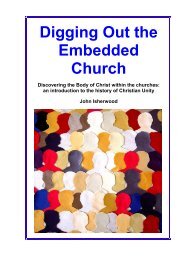Christian Unity (the book) - The Maranatha Community
Christian Unity (the book) - The Maranatha Community
Christian Unity (the book) - The Maranatha Community
You also want an ePaper? Increase the reach of your titles
YUMPU automatically turns print PDFs into web optimized ePapers that Google loves.
<strong>The</strong> Church of England has to be singled out as a very special kind ofProtestant Church, claiming to be both Catholic and Protestant. Politicalevents brought it into being as an established State Church in 1534 underHenry VIII. It still retains its legal connection to <strong>the</strong> State to this day, despitecalls over very many years for its disestablishment. On <strong>the</strong> Continent <strong>the</strong>reare countries such as Sweden which have established churches, but dissent isnow tolerated, officially at least, everywhere in European countries.In <strong>the</strong> Reformation period differences between <strong>the</strong> mainstream Protestantchurches were not about <strong>the</strong> classical Christological and Trinitarian Confessionsof <strong>the</strong> Church universal, but about baptism, <strong>the</strong> Lord’s Supper and Churchorder. <strong>The</strong>se were all issues in which <strong>the</strong>y also differed from <strong>the</strong> Catholic andOrthodox Churches.Episcopacy was retained by <strong>the</strong> Church of England and Lu<strong>the</strong>rans, while <strong>the</strong>Calvinists followed a Presbyterian 51 form of government. By <strong>the</strong> late 16 thCentury, Congregationalist ideas of church governance were appearing insou<strong>the</strong>rn England (<strong>the</strong> ‘Brownists’) and were to become a permanent featureof <strong>Christian</strong>ity in Britain. All <strong>the</strong>se churches practiced infant baptism, thoughdenying a Catholic doctrine of baptismal regeneration. By <strong>the</strong> 17 th Century,Anabaptist ideas from <strong>the</strong> continent lead to <strong>the</strong> formation of Baptistcongregations, which were Congregationalist in church order and practisingcredo- (believers’) baptism.<strong>The</strong> sad experience of <strong>the</strong> Colloquy held in Poissy (1561), just north of Paris,must be mentioned here. Huguenots (French Protestants) and <strong>the</strong> CatholicChurch met to promote unity at a conference convened by <strong>the</strong> Queen Regent,Ca<strong>the</strong>rine de Medici. It lasted about a month.<strong>The</strong>odore Beza and Peter Vermigli, a Calvinist and a Zwinglian, led <strong>the</strong>argument from <strong>the</strong> Protestant side. Beza began by urging <strong>the</strong> delegates not todeny <strong>the</strong>ir differences nor fail to assert <strong>the</strong>ir close agreement on many pointsof doctrine. However, his assertion that while <strong>the</strong> Eucharist was not just acommemoration of Jesus’ death, nei<strong>the</strong>r was it a literal partaking of his body,which was in heaven and not on altars, caused <strong>the</strong> greatest disturbance among<strong>the</strong> Catholics, and led to cries of ‘blasphemy’ and hissing.51 Presbyterian. <strong>The</strong> Presbyterian form of Church order was by <strong>the</strong> rule of elders(‘presbuteroi’ in <strong>the</strong> Greek of <strong>the</strong> New Testament) over a congregation. As Presbyterianismdeveloped, congregations became linked toge<strong>the</strong>r under <strong>the</strong> guidance of regional councils,presbyteries and synods. In Scotland, Prebyterianism is <strong>the</strong> established, national Church. InHolland it became <strong>the</strong> officially approved Church body, if not formally established.Page 73








